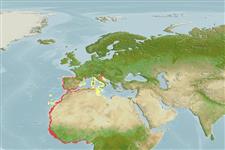Common names from other countries
Environment: milieu / climate zone / depth range / distribution range
Ecologie
marien demersaal; diepte 10 - 50 m (Ref. 2683). Subtropical; 45°N - 4°N, 18°W - 17°E
Eastern Atlantic: southern Bay of Biscay to Ghana, including the western Mediterranean. Reported from the Gambia River (Ref. 28587).
Grootte / Gewicht / Leeftijd
Maturity: Lm ? range ? - ? cm
Max length : 50.0 cm TL mannelijk / geslacht onbekend; (Ref. 26999); common length : 35.0 cm TL mannelijk / geslacht onbekend; (Ref. 3397)
Dorsale zachte stralen (totaal): 19-21. Caudal fin rounded (Ref.5377).
Sedentary species which occurs on soft sand or mud, often partly buried or concealed in rock crevices, solitary in shallow water. Feeds on crustaceans, mollusks and small fishes (Ref. 7405). The female lays eggs which are large enough and which are turned over to the males who guard them (Ref. 5377). A species that is not venomous (Dr. Andread Kunznmann, Leibniz Centre for Tropical Marine Research (ZMT), pers. communication 10/2021).
Levenscyclus en paargedrag
Maturiteit | Voortplanting | Paaien | Eieren | Fecunditeit | Larven
Bauchot, M.-L., 1987. Poissons osseux. p. 891-1421. In W. Fischer, M.L. Bauchot and M. Schneider (eds.) Fiches FAO d'identification pour les besoins de la pêche. (rev. 1). Méditerranée et mer Noire. Zone de pêche 37. Vol. II. Commission des Communautés Européennes and FAO, Rome. (Ref. 3397)
Status op de Rode Lijst van het IUCN (Ref. 130435)
CITES (Ref. 128078)
Not Evaluated
Gevaar voor de mens
Harmless
Gebruik door de mens
Visserij: van minder commercieel belang
Meer informatie
Lokale namenSynoniemenMetabolismePredatorenEcotoxicologieVoortplantingMaturiteitPaaienFecunditeitEierenOntwikkeling van de eieren
ReferentiesAquacultuurAquacultuurprofielKweeklijnenGeneticaElectrophoresesErfelijkheidZiektesVerwerkingMassaconversie
Tools
Speciale rapporten
Download XML
Internetbronnen
Estimates based on models
Preferred temperature (Ref.
115969): 15.5 - 27.5, mean 19.8 (based on 74 cells).
Fylogenetische diversiteitsindex (Ref.
82804): PD
50 = 1.0000 [Uniqueness, from 0.5 = low to 2.0 = high].
Bayesian length-weight: a=0.01175 (0.00470 - 0.02937), b=3.04 (2.83 - 3.25), in cm Total Length, based on LWR estimates for this (Sub)family-body shape (Ref.
93245).
Trofisch niveau (Ref.
69278): 4.0 ±0.64 se; based on food items.
Weerstandsvermogen (Ref.
120179): laag, minimale populatieverdubbelingstijd 4,5-14 jaar (Preliminary K or Fecundity.).
Fishing Vulnerability (Ref.
59153): Moderate vulnerability (40 of 100).
Climate Vulnerability (Ref.
125649): Moderate vulnerability (39 of 100).
